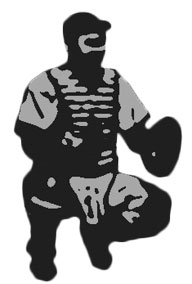Member Article
Catching Science
 “People ask me what I do in winter when there’s no baseball. I tell you what I do. I stare out the window and wait for spring.”
“People ask me what I do in winter when there’s no baseball. I tell you what I do. I stare out the window and wait for spring.”
-Rogers Hornsby
Home plate was round, something like a dinner plate, when baseball was born in the 19th century, but it was difficult to call balls and strikes. So the plate was converted to a pentagon shape that, it is often said, points to the most important player on the field — the catcher.
One of us played catcher in high school (J.R.A., the son), and the other (R.M.A., the dad) was always stationed 5 to 12 feet behind, watching every play without even a pretense of objectivity. The dad is also a psychological scientist (of the social-psychology tribe) who spent time during games considering the psychology of the sport. The ball is in play for only about 12 minutes and 22 seconds of an average 2 hour and 48 minute game, so there was ample time for theorizing.
The role of the catcher in baseball is demanding. A skilled catcher must have lightning-fast judgment, be capable of complex statistical analysis, and have highly developed organizational as well as leadership skills. Oh, and good knees help, too.
Clarity and certainty are preeminent social motives (e.g., Fiske, 2004): people want to know things quickly and clearly so they can predict things well enough to function in daily social life (e.g., Heider, 1958). One way people approach predictions is through a concept called theory of mind, which has been identified as a critical element in the emergence of complex social behavior. Theory of mind is the capacity to attribute mental states (e.g., beliefs, intents, desires, knowledge, pretending, etc.) to oneself and to others, and to understand that others have beliefs, desires, intentions, etc., that may be different from one’s own.
The medial prefrontal cortex (PFC) has been identified as a hub for this social-information processing (Baron-Cohen, 2011). More specifically, the ventromedial PFC enables you to compare your own perspective to someone else’s (Baron-Cohen, 2011), and it makes social bonding and the emergence of culture possible. True empathy, for instance, could not be possible without this capability (Baron-Cohen, 2011); teamwork and cooperation would also be impossible (e.g., de Waal, 2009).
Baseball historians view the evolution of the catcher position in a way that’s similar to how psychological scientists view the evolution of the cortex. The position used to be called “the behind” and was located way, way behind the batter, but the catcher slowly moved up to be adjacent to the hitter (Morris, 2009). Catchers gradually assumed a crouching position (and, most importantly, finally got some padded equipment), and ultimately the catcher became a social animal, a leader, and a field general (the metaphors are legion; see Morris, 2009).

APS Fellow Robert M. Arkin
Catcher is a unique position on the baseball field. Squatting awkwardly in heavy gear and using one’s body to block the baseball may appear brutish compared with the graceful stances and fluid movements of the other positions. Yet catching involves mental gymnastics well beyond those required of any other player.
Only the catcher is positioned to see the entire field of play, including the hitter, and it is the catcher who triggers virtually every action by calling the pitches. [1] The catcher makes calls based on a complex array of data that he processes in a split second. He must be aware of every aspect of the game at all times, particularly the perceived strengths and weaknesses, as well as preferences and desires, of the hitter (the opponent) and his own teammates. He must keep the score, the inning, and the number of outs in mind. He has to know what the count is [2] and what the batter did the last time he was up to bat as well as in prior games. Is the pitcher’s curveball working today? Does the umpire have a loose or a tight strike zone? Does the batter dig in? Is his weight leaning forward or on his heels? Do the runners have large leads, and which way are they leaning? These perceptions, judgments, and decisions run through a catcher’s mind before he calls a pitch. Each decision is critical, because the outcome of the game could turn on

James R. Arkin
any one. The complexity seems daunting. But, like a chess master — or a master of any other talent that involves an opponent and/or a team — catching relies on emotional intelligence and perspective taking, which depend on the thoughts and feelings that run through the medial prefrontal cortex hub.
Psychological scientists and behavioral economists are catching on to the science of catching. We now know that the umpire’s strike zone shrinks considerably when there are two strikes on the batter; many pitches that are technically within the strike zone are called balls, not strikes, when the latter would result in a “called” third strike (Moskowitz & Wertheim, 2011). Conversely, the umpire’s strike zone is 93 square inches larger on a three-ball count than the strike zone on two-strike counts! Experienced catchers know this.
Three years of Major League Baseball data (more than 2.5 million pitches) show that the catcher will call a different pitch for a 3-2 count that started off as an 0-2 count than for a 3-2 count that started off as a 3-0 count (Moskowitz & Wertheim, 2011). Consistent with the principle of loss aversion, the 0-2 start produces far fewer fastballs (and more change-ups and curveballs) than the 3-0 start. As Kahneman and Tversky foreshadowed in Prospect Theory (1979), the pitcher who starts off 0-2 is 51.5 percent likely to throw a fastball, 21.0 percent likely to throw a curve, and 8.2 percent likely to use a changeup; facing the same full count, but with a 3-0 start, the fastball is 4.0 percent more likely, curve 4.0 percent less likely. Change-ups and curveballs are aggressive, but they are more risky (because they are more difficult to control), and no catcher wants to let a batter reach base who started with a 0-2 count. Catchers may not be consciously aware of the power and influence of loss aversion on their calls, but at some level, it appears they might be, because a 4-percent shift toward risky pitch-calling actually seems pretty modest.
If the previous pitch was a fastball, and the hitter’s swing was behind it, a curveball or change-up may catch the hitter off guard. If the hitter is crowding the plate, a fastball on the inside part of the plate is difficult to hit, and it often results in a weak ground ball or at least gets the hitter to back off from the plate. If the first pitch was a fastball during the hitter’s previous at-bat, he likely won’t swing at a curveball on the first pitch, making it a free pitch to get ahead in the count. If the hitter made it to second base on an inside fastball in his first at-bat, the catcher might call for pitches on the outside part of the plate. If the hitter hit a foul ball off a pitch out of the strike zone on a two-strike count, the catcher might move farther out of the strike zone, tempting the hitter to swing at increasingly bad pitches. A catcher has to encode and recall the details of each batter and each at-bat, and use theory of mind to gauge the hitter’s expectations and the pitcher’s capabilities; then the catcher has to execute his calls without the benefit of stopping to use a pencil and paper.
Catchers cannot make pitchers throw perfect games, at least not often. There have been only 18 perfect games [3] thrown in the modern era. Pitchers often lose control of their accuracy seemingly for no reason, and once a pitcher begins to struggle, it becomes more and more difficult to pull out of the spiral. Some days, a pitcher with a brilliant curveball will lose his control and throw every single breaking pitch into the dirt. As the players who must sacrifice their body to block the pitch each time the ball hits the dirt, catchers are acutely aware when a pitcher is struggling. And their trips to the mound to confer with the pitcher are as much for therapeutic reasons as they are for strategy or talking about pitching mechanics. There is a relationship between pitcher and catcher, to a point where the catcher anticipates the pitcher’s struggles, senses his confidence, and can call pitches that will settle the pitcher’s feelings.
As the position evolved, the player behind the plate became the brains of the operation. The catcher’s visit to the pitcher’s mound exemplifies this. A talk with a pitcher who is struggling — whether to give advice, to motivate, or to tell a joke — suggests leadership. The literature often defines leadership in terms of the persons who are in charge of organizations (e.g., Kaiser, Hogan & Craig, 2008), but we note that the catcher has a role-conferred advantage (Ross, Amabile, & Steinmetz, 1977). Catchers often become the captains of their teams, and can grow into coaches and managers, in part because they have the opportunity to show their leadership — that is, if they have it, or can develop it. Albus Dumbledore, of Harry Potter fame, said, “It is a curious thing, Harry, but perhaps those who are best suited to power are those who never sought it … those who, like you, have leadership thrust upon them, and take up the mantle because they must … and find to their own surprise that they wear it well” (Rowling, 2007, p. 718). Catchers are thrust into a role that demands leadership, and only those who are willing to take up the mantle find success in the position.
On the Internet (e.g., Wikipedia), people have listed the “distinctive elements” of the game of baseball: No clock to kill; the uniqueness and quirks of each ballpark; the only game in which the defense has the ball; an individual sport. We take issue with the last element, because, as we see it, baseball is more like a community, town, culture, or nation. Everyone has to play her or his role: butcher, baker, provost, professor. All these occupations seem individual in their own way, but only when theory of mind, empathy, and cooperation prevail (de Waal, 2009) does the group succeed.
Authors’ Note: Thanks to James Tootle, J. D. Arkin, and Jordan Arkin for their reading and critique of an earlier draft. They all played varsity high school baseball and all love the game. Their insights were invaluable.
Footnotes
[1] Pitchers generally have two or more grips, as well as styles of pitch that vary from fastballs to off-speed pitches that curve in or out. Some can even throw pitches that don’t spin at all. The catcher signals which should be delivered and then uses the mitt to give the pitcher a target. Return to Text
[2] Each batter is entitled to continue as batsman up to a third “strike” (balls thrown over the plate above the knees and below the chest), and a series of four “balls” entitles the batsman to a free ride (a “walk”) to first base. The count is the number of balls — and strikes — as in, say, “3-2 count,” which is usually called the “full count.” Return to Text
[3] A perfect game is a game in which a pitcher (or combination of pitchers) pitches a victory that lasts a minimum of nine innings and in which no opposing player reaches base. So, there are no hits, walks, hit batsmen, and no opposing player reaches base for any other reason (e.g., pass ball behind the catcher). In short, there are 27 players up to bat, and 27 players retired as outs. Return to Text





APS regularly opens certain online articles for discussion on our website. Effective February 2021, you must be a logged-in APS member to post comments. By posting a comment, you agree to our Community Guidelines and the display of your profile information, including your name and affiliation. Any opinions, findings, conclusions, or recommendations present in article comments are those of the writers and do not necessarily reflect the views of APS or the article’s author. For more information, please see our Community Guidelines.
Please login with your APS account to comment.